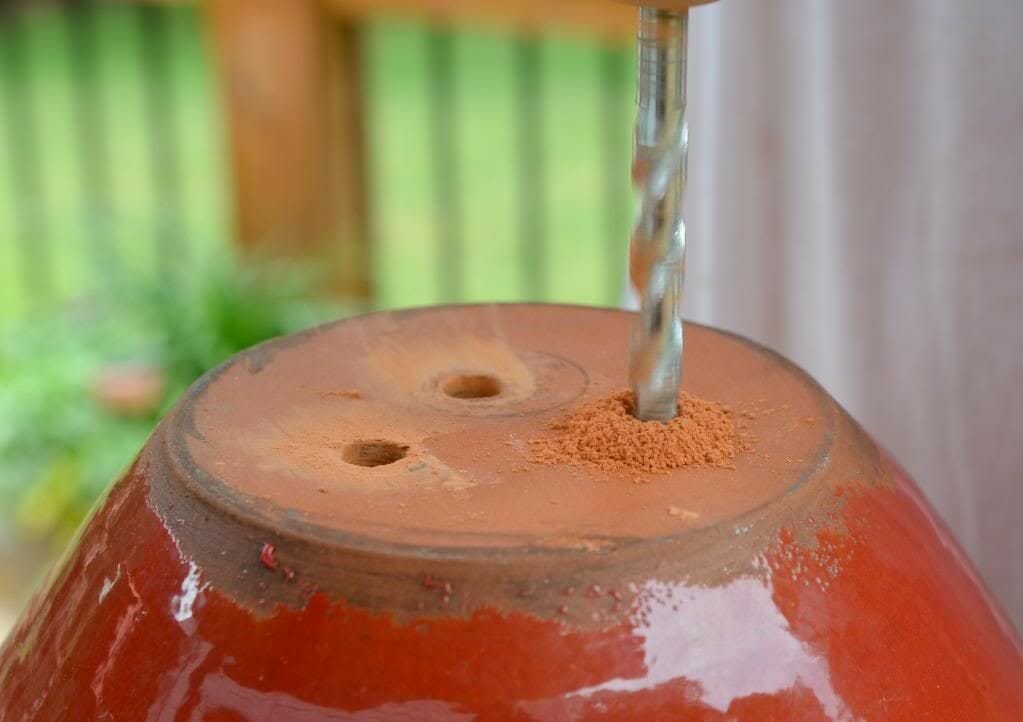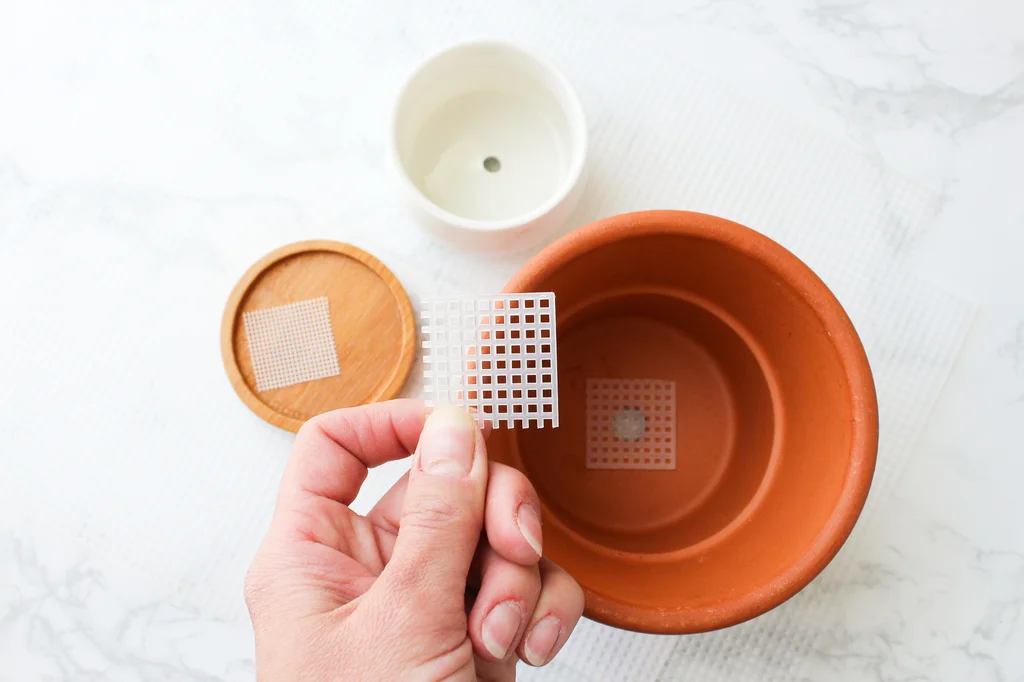If you are a new plant parent, the No 1 rule is: Do not buy the pots just because they look pretty. If you like a pot, turn it over and check if it has the most essential feature, i.e., a drainage hole. Drainage can confuse many beginners because it is the most crucial factor affecting the plant’s growth. So drainage holes in pots are a must if you want to see your green buddies happy.

What are drainage holes?
Drainage holes are small openings in the bottom of a pot. Some pots have a single hole, whereas others may have 4-6 holes. When you water the plant, the excess water drains out of these tiny holes. They are essential for indoor pots because they help drainage and prevent water from sitting in the bottom of the pot, which can lead to many problems for plants.
Drainage holes are important?
On the watering day, we plant lovers want to drench plants in water. If the water is not dripping from the bottom, we feel the plant is not adequately watered. Overwatering becomes problematic if there is no source to get the excess water out. So that is why the tiny drainage holes at the bottom of the indoor pots are essential.
Drainage holes are important to pots as they help promote drainage and aeration while preventing waterlogging. These tiny openings also help to reduce the risk of overwatering. When the excess water remains in the pot, it can affect the plant in various ways. Since the soil has already absorbed the water, the extra moisture leads to root rot. And root rot, if not identified and treated, can result in the death of the plant.
However, if you get a pot with these holes at the bottom, you will know when to stop watering because the water will start dripping from the openings. This way, you can reduce the risk of overwatering and damage to the roots.

How to find drainage openings in pots?
The drainage hole is typically located near the bottom of the pot. Usually, terracotta pots have a single opening, whereas plastic nursery containers have many holes. Some pots, like decorative plastic ones, may have a single hole on the side covered by a small plug. Ceramic pots usually come without any holes for drainage, so you may have to drill them for water to pass through easily.
When choosing a pot for your plants, be sure to pick one that has drainage holes. If unsure, ask a salesperson at your local garden center or nursery.
Number and Position of holes:
Generally, a single drainage hole in the middle of the pot is fine. However, it depends upon the material of the pot. For terracotta and ceramic planters, a single hole is sufficient, but for plastic ones, there should be 4-5 holes for proper drainage of water.
Moreover, the drainage holes in your pot should be positioned so water can quickly drain out of the pot. If the pot has a single hole, the ideal position is the center of the container. However, in case of more holes, the placement must be done in a way that they are at the edges of the pot, away from the center.

Is there any need to cover drain holes?
Many people place a rocky layer of gravel or pebbles over the openings to improve the drainage of potted plants. However, according to experts, this is not necessary. In fact, it can lead to blockage of the holes. Moreover, in a pot size of 4-5 inches, if you add a 1-inch layer of rocks, the roots will get less room to grow. Therefore, covering the bottom hole with any layer is not recommended.
Although drainage holes are significant for the growth of plants, they can be a source of mess inside the house. When you move the pot, the soil falls out of the pot. So, to prevent this, you can cover the drainage holes with something that doesn’t hold onto moisture.
- A small mesh works well to stop the soil from falling out. Plastic mesh is a better option, as the metal mesh can rust due to moisture inside the soil.
- A single piece of a broken terracotta pot also allows the water to drain well while covering the drainage hole.
- You can also use coffee filters, but they will break down eventually, and you will need to replace them. Fabric liners can be an alternative to coffee filters as they fulfill the purpose and do not break down easily.
What to do if my pot does not have a drainage hole?
If your pot doesn’t have drainage holes, there is no need to worry. You can make openings in the pot by using a simple drill machine. With the help of a drill machine, you can get as many holes as you want according to your pot. By drilling holes, you can also turn other household items like mugs, bowls, etc., into pots. But make sure that the material doesn’t shatter. When drilling drainage holes into a pot, wear safety goggles and work slowly to avoid cracking or chipping the pot.

Can I grow plants in the pot without drainage holes?
There is no denying the importance of drainage holes. But if you want to pot your plants in containers that do not have drainage holes, you can very well do that. You need to take certain measures to prevent over watering and root rot. So that your plant grows and remains healthy.
- Add a layer of rocks to the bottom.
If you want to use a cute or fancy decorative pot with no hole to drain excess water, you can place rocks at the bottom. An 1-2 inch layer of non-organic material like rocks, gravel, or pebbles covering the bottom of the pot will act as a drainage layer. This way, water will reach the bottom layer and not stand near the roots. However, you need to add little water because there is no way for excess water to drain out of the pot.
- Put a plastic nursery pot inside it.
Another option is to use plastic nursery pots. You can place these pots with a drainage tray inside the decorative container. This way, watering will be easy as the excess water can collect in the tray inside the decorative pot. So, your plant’s roots will not be affected in case you over-water the plant.
The best soil for a pot with drainage holes:
The soil you use in your container having holes for draining the water is essential. Be sure to use light, well-draining soil that won’t compact or become waterlogged. Good potting soil is the one that can retain moisture yet drain the excess water. Also, it holds nutrients and provides airspace in the soil for roots to grow.
A good solution is adding soil amendments to your regular soil to make a mix that will suit your plant’s needs. A potting mix containing perlite or vermiculite helps improve drainage. You can also make your well-draining soil mix by combining equal parts of sand, peat moss, and perlite. These soil amendments are light in weight and porous, increasing the draining ability of the soil. If you want to know more about soil amendments, read this article https://plantergalleria.com/improve-the-drainage-in-potted-plants/
Common problems with drainage holes:
- Clogging:
One of the most common problems with drainage holes is that they can become clogged with soil or debris over time. This can happen if the potting mix is too dense or if there is not enough gravel in the bottom of the pot.
Solution: To prevent this from happening, be sure to clean out the drainage holes regularly. You can use a small brush or toothpick to remove any accumulated debris in the holes.
- Fast Drainage:
If there are many holes in the pot, or the material of the pot is too porous, it will allow water to escape from the pot too quickly. This can cause the plant’s roots to dry out, leading to stress in the plant. Moreover, as the water drains quickly, the nutrients also flush out, and the plant does not get to absorb them properly.
Solution: To prevent this, use a potting mix containing plenty of organic matter, such as peat moss or compost. This will help hold moisture in the pot and make it less likely for water to escape through the drainage holes.
Conclusion:
Thank you for reading this post! If this article was helpful to you, please leave a comment below. If you have any other queries, please check www.plantergalleria.com for more articles.
Frequently Asked Questions:
1. How big should drainage holes be in pots?
To provide drainage, 3-4 holes of 1/4 inch at the bottom of the pot will suffice. However, if the holes are larger than 1/4 inch, then too much soil will escape.
2. Are pots with drainage holes better?
After watering the plant, the soil absorbs the moisture. The excess water sinks to the bottom of the water. The stagnant water can affect the roots if no hole is present at the bottom. However, when water drains out of the hole, it avoids the risk of overwatering. So, pots with drainage holes are a better option.
3. What plants can grow in pots without drainage holes?
The plants that require low water for their growth, like Snake plant, Pothos, Aloe Vera, Red Aglaonema, etc., can grow in pots without drainage holes.



2 Comments
The Best Indoor Planter with Stand Options for You - Planter Galleria
June 20, 2022[…] While buying a planter, check whether there is a drainage hole present in it? Each plant is different and has different watering needs. A drainage hole prevents you from overwatering your plants and keeps them in healthy conditions. However, most of the planters in the market are without drainage holes. So, their purpose is to hide your simple plant pots beautifully. Check this article so that you can get an understanding of drainage in pots https://plantergalleria.com/do-you-need-drainage-holes-in-pots/. […]
10 Best Indoor Terracotta Pots for Your Plants - Planter Galleria
June 28, 2022[…] pots come with a drainage hole at the bottom. So, you don’t have to worry about your plants getting damaged by excess […]